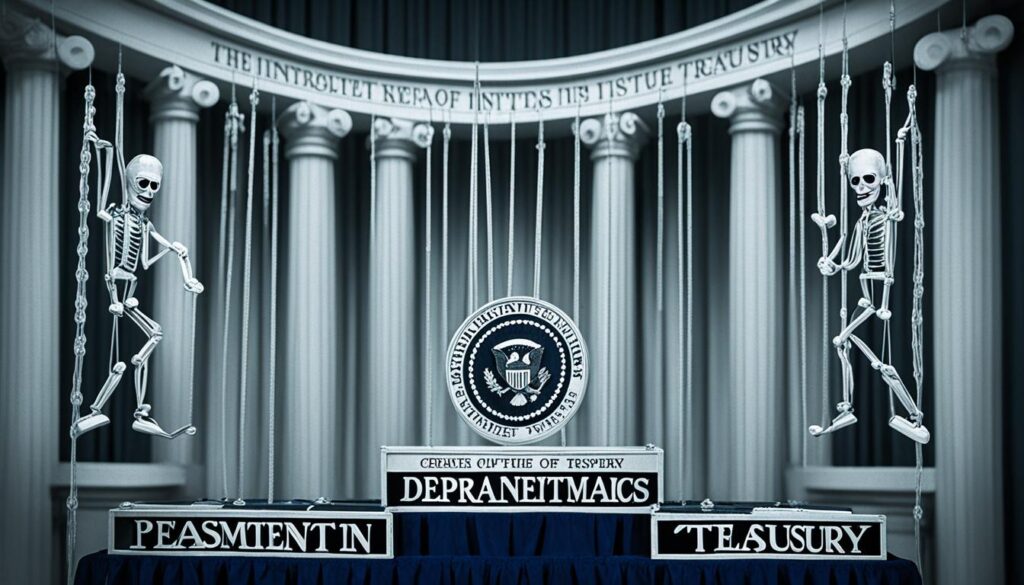If you eat hamburgers daily (and you are not a cattle rancher), would you wish for high or low beef prices? This riddle may seem unrelated, but it holds a key to understanding the alleged fraud and market manipulation carried out by the Silver Institute for over 20 years. Our research has uncovered a sick scam orchestrated by the institute, aimed at guaranteeing low silver prices for their three chief clients.
The Silver Institute, an influential organization in the silver industry, stands accused of removing the operant word “wish” from the riddle and actively working to manipulate the silver market. This scandalous revelation has sent shockwaves through the industry and raised a red flag for potential investors.
According to our findings, the Silver Institute’s scheme primarily benefits three major clients: the Federal Reserve, the Department of Treasury, and the Military Industrial Complex. These influential entities have a vested interest in ensuring low silver prices for various reasons.
The Federal Reserve, as the primary authority responsible for monetary policy, sees silver as a potential competitor to the fiat currency system. Recognizing that silver holds intrinsic value and can be used as currency, they have allegedly collaborated with the Silver Institute to suppress silver prices. This ensures their monetary dominance remains unchallenged.
Similarly, the Department of Treasury has a vested interest in maintaining low silver prices. With silver’s potential as a form of money, a rising silver market could undermine the stability of the US dollar, affecting their control over the country’s monetary system.
The third client benefiting from the Silver Institute’s market manipulation is the Military Industrial Complex. As the top user of silver, they have a strong need for a steady and affordable supply. By working to guarantee low silver prices, the Silver Institute indirectly supports the military’s access to silver for the production of various defense systems.
These shocking revelations have put a spotlight on the Silver Institute and its directors, who have been implicated in fraudulent practices and market rigging. The silver community is calling for a thorough investigation into these allegations and demanding justice for silver investors who may have been unknowingly affected by this scam.
The repercussions of the Silver Institute’s actions go beyond the manipulation of market prices. It raises critical questions about the transparency and integrity of the silver industry as a whole. To regain trust and ensure a fair market, it is imperative that the Silver Institute and its directors face accountability for their alleged involvement in this scandal.
Stay tuned for more sections in this series, where we will delve deeper into the evidence supporting these claims and shed light on the true extent of the silver market manipulation orchestrated by the Silver Institute.
US Silver Stockpile Raided by Defense Department
In a shocking revelation, it has been discovered that the US Defense Department has raided the silver stockpile. This incident has raised concerns about the integrity of the silver market and the role played by influential entities.
Banks and defense contractors are being accused of suppressing the silver price through their involvement in these illegal activities. The Defense Department’s involvement in such actions has sent shockwaves through the industry, as their role is typically seen as one of protection and security.
This incident brings to light the potential for manipulation and price suppression within the silver market. It raises questions about the fairness and transparency of the industry, particularly when powerful entities like the Defense Department are implicated.
As investigations unfold, the market is left grappling with the impact of these actions. The manipulation of silver prices not only affects investors but also has broader implications for the economy and market stability.
The raiding of the US silver stockpile by the Defense Department serves as a stark reminder of the potential risks and vulnerabilities within the market. It underscores the need for increased oversight and regulation to prevent such incidents from reoccurring in the future.
Timeline: Silver Raid by US Government
The timeline of the silver raid by the US government sheds light on a series of events that raise concerns about the integrity of silver reporting and the existence of a strategic silver stockpile. It is essential to examine the cessation of silver reporting and the implications it may have had on the silver market.
In 1979, the United States Bureau of Mines initiated the practice of reporting on silver inventories. This provided transparency and valuable insights into the supply and demand dynamics of the silver market. However, 17 years later, in 1996, this reporting abruptly came to an end.
Interestingly, the cessation of silver reporting coincided with the closure of the United States Bureau of Mines. The responsibility for silver usage reporting was then shifted to the United States Geological Survey. This covert shift raised suspicions among industry experts and investors, who questioned the motives behind the move.
What is especially concerning is the potential existence of a strategic silver stockpile that may have prompted the cessation of silver reporting. The sudden lack of transparency makes it difficult to assess the true state of silver supply and demand, leaving investors and market participants in the dark.
If you want to assess the true health of the silver market and make informed investment decisions, understanding the timeline of the silver raid by the US government is crucial. The abrupt cessation of silver reporting and the possibility of a strategic silver stockpile raise important questions about the integrity and transparency of the silver market.
The Manhattan Engineering District and Silver
The Manhattan Engineering District, also known as the Manhattan Project, played a significant role in the use of silver. Silver was used in the production of enriched uranium for atomic bombs. The project involved the nationalization of silver reserves and the extensive use of silver in various military applications. This connection highlights the importance of silver in the defense sector.

The Manhattan Engineering District was a top-secret research and development program during World War II, tasked with developing the first atomic bomb. Led by prominent scientists such as J. Robert Oppenheimer and Enrico Fermi, this project revolutionized the field of nuclear physics and forever changed the course of history.
Within the Manhattan Project, silver played a crucial role in the production of enriched uranium. Enriched uranium, in turn, was used as the primary fuel in nuclear reactors and the explosive core of atomic bombs. The addition of silver to the uranium fuel helped enhance its stability and efficiency in nuclear reactions.
In addition to its use in enriching uranium, silver found widespread application in various military components and equipment. It was utilized in electrical contacts, switches, and connectors due to its excellent conductivity. Silver coatings were also applied to mirrors and lenses for optical systems, improving their reflectivity and performance.
The strategic importance of silver during the Manhattan Project led to the nationalization of silver reserves in the United States. The government needed a secure and reliable supply of silver to meet the demands of the project. As a result, mining operations and silver production were closely monitored and controlled.
Furthermore, the extensive use of silver in the defense sector highlighted its unique properties and versatility. Silver’s antimicrobial and corrosion-resistant qualities made it ideal for coating and protecting sensitive military equipment. It also played a crucial role in the development of advanced radar systems and electronic components.
The connection between the Manhattan Project and silver usage underscores the integral role played by this precious metal in defense and national security. Its unique properties and applications continue to make silver a vital resource in various military and aerospace technologies.
Silver Institute’s Denial of Silver’s Criticality
The Silver Institute, a prominent industry organization, has faced allegations of downplaying the criticality of silver, despite its significant use in military and aerospace applications. Interestingly, the Department of Energy and the US Geological Survey do not recognize silver as a critical mineral, raising concerns about the transparency and integrity of the Silver Institute’s operations.
Silver plays a vital role in various military and aerospace technologies, including electronic circuitry, radar systems, and space exploration equipment. It is also used in high-performance batteries and photovoltaic cells. Despite its extensive and essential applications in these sectors, the classification of silver as a critical mineral is subject to debate.
This denial by the Department of Energy and the US Geological Survey calls into question the comprehensive understanding and recognition of silver’s importance. It highlights the need for further evaluation of the criticality criteria and potentially reevaluating the classification of critical minerals. The Silver Institute’s stance on silver’s criticality adds to the ongoing discourse regarding the significance of this precious metal in various industries.
In the broader context, the controversy surrounding the criticality of silver raises broader questions about the criteria used to determine the importance of minerals and the influence of industry organizations on these classifications. The silver community and stakeholders in the defense and aerospace sectors are closely watching developments to ensure a fair and accurate evaluation of silver’s critical role in technology and national security.
Challenging the Status Quo
The denial of silver’s criticality by the Department of Energy and the US Geological Survey prompts a closer examination of the criteria used in determining the importance of minerals. This controversy has ignited a debate about the potential bias and influence of industry organizations, such as the Silver Institute, in shaping these classifications. It is crucial to question preconceived notions and challenge established narratives to gain a comprehensive understanding of the true value and criticality of silver in today’s technological landscape.
Silver’s Importance in Military and Aerospace
Silver is a critical component in various military applications and the aerospace industry, playing a vital role in the development and operation of sophisticated defense systems. Its unique properties make it indispensable in these sectors.
Within the military domain, silver finds extensive use in the manufacturing of bombs, missiles, shells, rockets, satellites, fighter jets, and torpedoes, among other essential equipment. Its exceptional conductivity, durability, and resistance to corrosion make it an ideal material for electrical contacts and connectors in these advanced systems.
One notable application of silver in military equipment is in the production of silver zinc batteries. These batteries are highly valued for their compact size, lightweight properties, high discharge rates, and stable voltage output. They provide critical energy storage solutions for military devices requiring reliable and high-performance power sources.
The aerospace industry also heavily relies on silver for its technological advancements. Silver-coated surfaces are commonly used in spacecraft, satellites, and other aerospace components to manage thermal radiation and control temperatures. The exceptional heat reflectivity of silver ensures optimal thermal management and helps safeguard sensitive instruments and equipment from potential heat-related damages.
Moreover, silver’s antimicrobial properties are extremely valuable in aerospace applications, as they inhibit the growth of bacteria and other microorganisms. This antimicrobial protection is crucial for maintaining a clean and sterile environment within the confined spaces of spacecraft and other aerospace vehicles.
Overall, the importance of silver in military and aerospace applications cannot be overstated. Its unique properties and versatile nature make it an essential element in the development, manufacturing, and operation of critical defense systems and aerospace technologies.
Silver’s Contribution to Defense and Space Exploration
In the defense sector, silver’s exceptional conductivity, durability, and resistance to corrosion make it an ideal material for electrical contacts and connectors in sophisticated military equipment. The demand for silver in this industry is driven by the growing need for advanced weaponry and reliable power sources.
Similarly, in the aerospace industry, silver’s thermal management properties and antimicrobial characteristics are highly valued. From satellites to spacecraft, silver plays a crucial role in maintaining optimal temperatures and preventing microbial growth, ensuring the safety and longevity of aerospace equipment.
It is evident that silver’s importance in military and aerospace applications extends beyond its traditional monetary value. Its unique properties and versatile nature make it an invaluable resource in the pursuit of advanced defense systems and space exploration.
The Silver Institute’s Conflict of Interest
The Silver Institute is under scrutiny for its alleged conflicts of interest, specifically concerning its connections to the Department of Treasury and involvement in derivative trades. These accusations have raised concerns about the institute’s impartiality and integrity in advocating for the silver industry.
The Silver Institute’s ties to the Department of Treasury have led to suspicions that its actions may be influenced by government interests or policies. This raises questions about the objectivity of the institute’s advocacy for silver and whether its agenda aligns with the best interests of silver investors and market stability.
Additionally, the institute’s involvement in derivative trades has drawn criticism. Derivative trading is a complex and speculative financial practice that can introduce significant volatility to the market. The Silver Institute’s participation in such activities raises concerns about potential conflicts between its role as an advocate for silver and its involvement in trading practices that can impact silver prices.
Furthermore, the Silver Institute’s connections with the Economic Club of New York, an organization led by the NY Fed Chair, add another layer of concern. The Economic Club of New York is known for its influential network and discussions that shape economic policies and decisions. The Silver Institute’s affiliation with this club raises questions about its objectivity and independence in advocating for silver as an asset.
To maintain transparency and ensure the integrity of the silver industry, it is crucial for the Silver Institute to address these allegations of conflict of interest. Further investigation and accountability are needed to restore trust and confidence in the institute’s representation of the silver market.

Stay tuned for more revelations on the silver scandal in Section 8.
Unveiling the Silver Scandal
The actions of the Silver Institute have come under scrutiny and are being labeled as a silver scandal, with allegations of engineered price rigging that has significantly impacted silver investors. The evidence suggests that the institute has been involved in manipulating the market to the detriment of silver investors’ interests.
The silver community is rallying for justice, demanding accountability for those responsible and working towards the removal of the Silver Institute. It is imperative to restore trust and integrity within the industry.
Transparency and accountability are crucial factors that need to be prioritized to ensure a fair and just silver market. Investors deserve justice and the removal of any entity involved in unethical practices that undermine their investments.
As the evidence continues to emerge, it becomes clear that the silver scandal is not an isolated incident but highlights deep-rooted issues within the industry. The silver community remains determined to fight for justice and work towards the removal of the Silver Institute.
The True Value of Silver
The true value of silver extends beyond its monetary properties. While silver has long been recognized as a precious metal used for currency, its significance goes even further.
Silver plays a vital role in various industrial sectors, including its involvement in gold’s largest industrial use. Its exceptional conductivity and reflectivity make it an essential component in electronic devices, solar panels, and even medical applications.
Did you know? Silver is widely used in the production of photovoltaic cells, helping to harness solar energy efficiently and sustainably.
In addition to its industrial use, silver has historically served as a form of money. Throughout ancient civilizations and even into modern times, silver coins were widely used as a medium of exchange and a store of value.
Fun fact: The word “sterling” actually derives from “Easterling,” referring to silver coins originally minted in eastern Germany in the Middle Ages. These coins were known for their high quality and purity, establishing the British pound sterling as a reliable form of currency.
However, despite its industrial and monetary significance, the true value of silver has been overlooked in certain government records. Institutions like the Department of Energy have not fully recognized the critical role that silver plays in various industries. This lack of recognition raises questions about society’s understanding and appreciation of silver’s worth.
When considering the true value of silver, it is essential to recognize its pivotal role in both industrial applications and historical monetary systems. By acknowledging its importance in these realms, we can fully appreciate the multifaceted nature of this remarkable metal.
Conclusion
The Silver Industry Corruption and Silver Price Fixing Scandal have exposed the dark underbelly of the silver market, revealing a web of market manipulation and illegal practices. The involvement of prominent figures, including directors of the Silver Institute, has shaken the industry and raised serious concerns about the integrity and transparency of the silver market.
Further investigation into these allegations is crucial to hold responsible parties accountable for their actions and ensure a fair and equitable silver market. Market manipulation and price fixing erode investor trust and undermine the stability of the industry. It is imperative that measures are taken to restore confidence and maintain a level playing field for all market participants.
The Silver Industry Corruption scandal serves as a wake-up call to the silver community and regulatory authorities to be vigilant and proactive in identifying and eradicating unethical practices. Transparency, accountability, and fair market practices are paramount to ensuring a sustainable and thriving silver industry.
